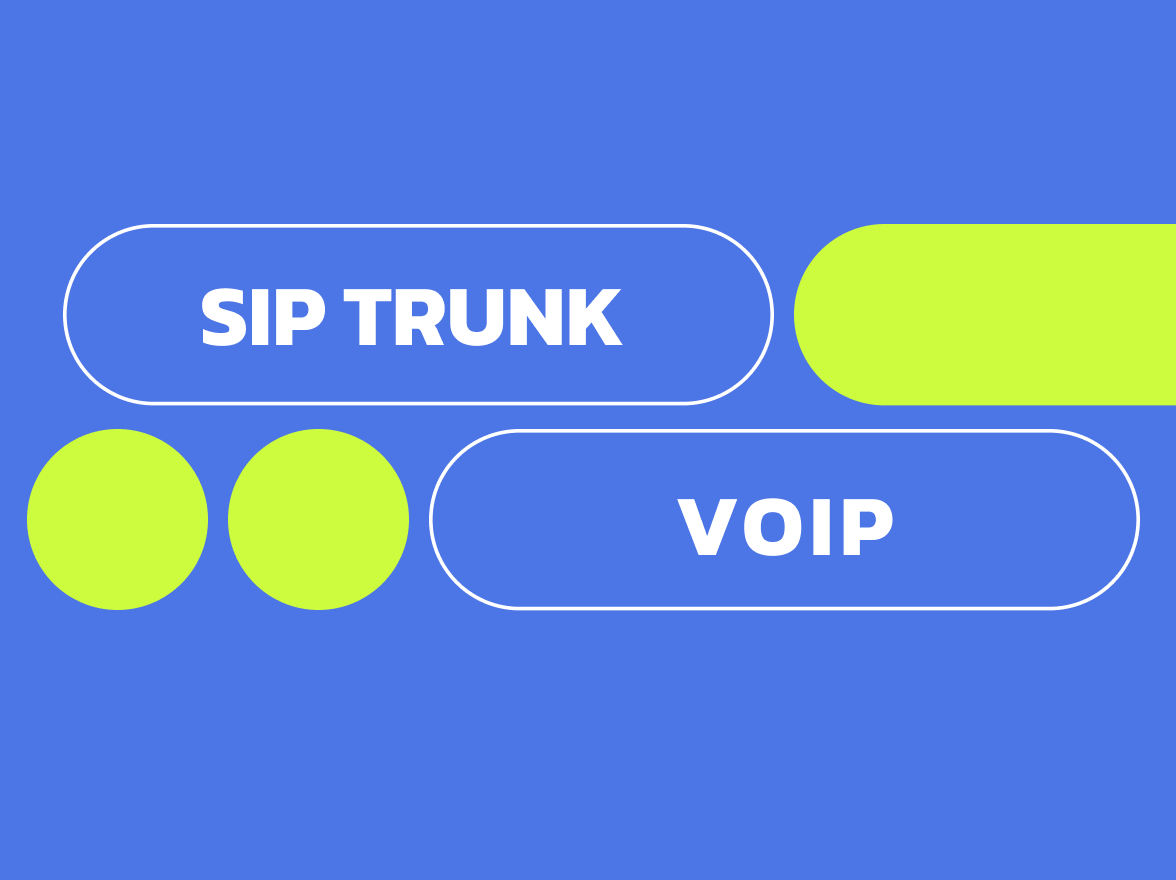Tech software for business communications is constantly changing and evolving. However, certain industry gold standards are considered a benchmark by every serious business. This article explores the differences, advantages, and setup processes of VoIP and SIP. Discover the two groundbreaking technologies that have changed how businesses communicate and operate.
What is VoIP?
Voice over Internet Protocol (VoIP) is a technology that allows voice interactions and multimedia sessions to be delivered digitally. It converts analog voice signals into digital data packets and transmits them over the internet or other packet-switched networks.
VoIP is an affordable alternative to traditional telephone services. Users can make voice calls from computers, VoIP phones, or traditional phones (or landline) with adapters.
How VoIP telephony works
When you speak into your device, your voice is converted from analog signals into digital data packets. These packets are then transmitted to the recipient. At the receiving end, the digital packets are reassembled and converted back into analog voice signals so the recipient can hear your voice.
The process involves codecs (coder-decoders) that compress and decompress the voice data to guarantee successful transmission. VoIP relies on protocols such as the Real-Time Transport Protocol (RTP) to transmit data. For setting up and managing calls, VoIP uses the Session Initiation Protocol (SIP).
Devices used in VoIP phone systems include:
- VoIP phones: Specifically created for VoIP calls.
- Traditional phones with adapters (ATAs): Allow existing phones to connect to VoIP networks.
- Computers with VoIP software (softphones): Start calls through call center software applications.
- Mobile devices with VoIP apps: Allow online calling from smartphones and tablets.
VoIP providers’ technology relies on a stable internet connection with sufficient bandwidth. Factors such as network latency, jitter, and packet loss can affect the quality of the service. Businesses often implement Quality of Service (QoS) settings to prioritize voice traffic over other data types to maintain call quality.
Hosted VoIP vs. non-hosted VoIP
- Hosted VoIP: A third-party provider manages all the VoIP servers and services off-site. The provider handles technical aspects, including maintenance, upgrades, and security.
- Non-hosted VoIP (on-premise VoIP): In this case, your IT team typically keeps and manages servers and hardware on-site. This option offers full control but requires significant investment in hardware and technical expertise, which can be rather expensive.
Pros and cons of VoIP
| Aspect | Pros | Cons |
|---|---|---|
| Cost | Reduces phone bills, especially for international business phone calls | Initial setup might require investment in good internet service |
| Flexibility | Use phone service on any internet-connected device | Quality depends strictly on internet bandwidth and stability |
| Scalability | It is easy to add new users without significant infrastructure changes | Scaling up may require advanced network management |
| Maintenance | Hosted solutions minimize in-house maintenance needs | In-house systems require ongoing technical support and updates |
| Emergency services | Modern VoIP systems can support E911 to handle emergencies | Emergency calls may fail if the internet or power is down |
VoIP offers substantial cost savings and flexibility across various devices and locations. However, its primary disadvantage is its dependency on a stable and fast internet connection, which can affect call quality and reliability.
What is SIP?
Session Initiation Protocol (SIP) is a signaling protocol that initiates, maintains, and terminates real-time conversation sessions over IP networks. These sessions can involve different means of voice and video interactions, or messaging applications. SIP is essential in VoIP technology, providing the framework for setting up and managing multimedia communication sessions.
How SIP works
SIP operates at the application layer, managing, modifying, and terminating sessions between two or more parties. When a SIP-enabled device starts a call, SIP handles the signaling and control messages necessary to set up the call. It determines the recipient’s location, determines session parameters (such as media types and codecs), and establishes the connection.
During the call, SIP can manage changes to the session, such as:
- Adding or removing participants: Allowing conference calls.
- Modifying media streams: Switching from voice to video.
- Call management actions: Transferring calls or placing them on hold.
When the call ends, SIP terminates the session. SIP works with other protocols:
- Session Description Protocol (SDP): Describes the media content of the session.
- Real-Time Transport Protocol (RTP): Handles the actual transmission of voice and video data.
Devices that use SIP include:
- SIP phones (hardware or software-based): For making SIP calls.
- IP PBX systems: Manage internal business phone systems over IP networks.
- Gateways: Connect traditional telephony systems to IP networks.
Pros and cons of SIP
| Aspect | Pros | Cons |
|---|---|---|
| Flexibility | Supports voice, video, and text interactions | Setup can be complex and depends on the network |
| Scalability | It easily expands to handle more calls or connections | It may require additional resources as the scale increases |
| Cost | It can reduce communication costs | Initial setup might be pricy due to equipment and configuration needs |
| Compatibility | Works with various communication tools and protocols | Compatibility issues might occur with older systems |
| Features | Offers advanced features like call forwarding and conferencing | Requires proper configuration to establish reliable features |
SIP significantly reduces communication costs and increases flexibility across multiple formats, including voice, video, and messaging. The main drawback is the potentially complex setup and configuration, especially when integrating with existing networks.
What’s the difference between SIP and VoIP?
Understanding the differences between SIP and VoIP is important for businesses, especially when looking for the right communication technology. Although they have similarities, they serve different roles in internet telephony. The table below outlines key distinctions between SIP vs VoIP, followed by detailed explanations of each point.
| Criteria | SIP | VoIP |
|---|---|---|
| Role in communication | Manages session signals | Transports voice data over the internet |
| Functionality | Handles call setup, management, and teardown | Converts voice signals into digital data packets for transmission |
| Media support | Supports voice, video, and messaging | Primarily supports voice conversations |
| Hardware dependency | Less dependent on specific hardware; works with various devices | Often requires IP phones or adapters for traditional phones |
| Flexibility and features | Offers greater flexibility with advanced features like conferencing and multimedia communication | Limited to voice features such as call forwarding and voicemail |
| Security | Offers advanced security features like encryption and authentication | It may have basic security but can be less secure if not correctly configured |
| Scalability | Highly scalable; easily add or remove lines and features | Scalability may be limited by hardware and network capacity |
Next, we will discuss what kind of role each technology plays in different business environments. That way, it will be a bit easier to decide which one you’ll need more – VoIP or SIP.
Role in communication
SIP primarily manages the signaling required to establish, maintain, and terminate sessions. It establishes the connection between two or more parties, making sure it is correctly initiated and properly terminated. SIP handles the setup and coordination of parameters, making it integral for starting calls and managing ongoing sessions.
VoIP, on the other hand, focuses on the actual transmission of voice data over IP networks. While SIP manages the signaling aspect, VoIP ensures that voice data is accurately delivered from one point to another, enabling precise and reliable voice interaction.
Functionality
SIP provides the framework for setting up and controlling sessions. It handles the complexities of business phone calls setup, management, and termination. Thanks to that, features like call routing, conferencing, and session management can adequately work. SIP ensures that communication sessions are established smoothly and maintained effectively, supporting various types of media and communication needs.
VoIP centers on transmitting voice communications digitally. It converts voice signals into digital packets and ensures their adequate transmission. VoIP’s primary function is to assist in the delivery of voice data. Thus, it lets users engage in voice conversations without using traditional telephone lines.
Media support
SIP offers strong media support by handling multiple communication channels, including voice, video, and messaging. Because of its adaptability, SIP may be suitable for unified communications platforms. Its capacity to handle numerous media formats improves teamwork and guarantees thorough communication inside businesses.
VoIP is primarily designed for voice communication. While some VoIP systems may offer limited support for video or messaging, their core functionality revolves around delivering high-quality voice calls. VoIP’s focus on voice ensures clarity and reliability in voice transmissions. However, for multimedia purposes, if you’re choosing between SIP and VoIP, it should be noted that SIP provides better support.
Hardware dependency
SIP is less dependent on specific hardware, offering greater flexibility in device compatibility. It can operate with various devices, including SIP phones, computers, and mobile devices, without any special hardware. This, in return, allows businesses to integrate SIP into their existing infrastructure without extensive hardware investments.
VoIP, however, often requires specific hardware to function at its optimum capacity. This includes IP phones or analog telephone adapters (ATAs) that convert traditional phone signals into digital data compatible with VoIP systems. Specific hardware needs can increase initial setup costs and limit device compatibility compared to SIP.
Flexibility and features
SIP provides greater flexibility by supporting advanced communication features such as call routing, conferencing, and multimedia transmission. These features let businesses manage complex communication needs effectively, develop collaboration, and improve productivity. SIP’s ability to integrate various communication tools makes it an outstanding option for organizations seeking broad communication solutions.
VoIP providers include basic communication features like call waiting, voicemail, and call forwarding. While these features are essential for standard voice interaction, VoIP’s feature set is more limited than SIP’s. This limitation may restrict businesses that require more advanced communication capabilities.
Security
SIP offers advanced security measures, including encryption and authentication protocols, to protect communication sessions from illegal access and potential threats. These features ensure that sensitive information transmitted during communication sessions remains confidential and secure. When applied, they make SIP a reliable choice for organizations that prioritize data security.
VoIP security largely depends on proper configuration and implementation. Without proper security measures, VoIP systems may be vulnerable to threats such as data interception. Strong security protocols are crucial for maintaining the integrity and confidentiality of VoIP interactions.
Scalability
SIP is highly scalable, letting businesses easily add or remove lines and features as needed without significant infrastructure changes. This scalability is essential for growing organizations that need to adapt their communication systems to meet increasing or changing demands. SIP’s flexible architecture supports easy expansion, making it an affordable solution for businesses of all sizes.
VoIP scalability may be constrained by physical hardware and network capacity. As businesses grow, expanding VoIP systems can require additional hardware investments and network upgrades, which can be expensive and time-consuming. This limitation may hinder businesses’ ability to scale their communication systems efficiently compared to SIP.
SIP phones vs. VoIP phones
SIP phones and VoIP phones are both used for making calls online, but they have some differences:
- SIP phones: Use the SIP protocol and can handle more than just voice calls. They support video calls, messaging, and conference calls because SIP allows for multiple types of communication.
- VoIP phones: Focus mainly on voice calls. They send voice data online using various protocols, including SIP. Features include holding calls, forwarding them, and showing caller ID.
Recommendation:
- Use SIP phones if your business requires advanced connection features like video conferences and integration with unified communications systems.
- Use VoIP phone systems if your needs primarily focus on voice calls with standard features. Use them if you’re looking for a more affordable solution.
SIP trunking vs. VoIP technology
SIP trunking and VoIP are integral to internet-based communications but serve different purposes. Understanding their differences helps businesses choose the right option.
- VoIP: A technology that allows voice communications to be transmitted online instead of traditional phone lines. It includes various protocols and methods for making voice calls online.
- SIP trunking: A service that uses SIP to connect an organization’s PBX (Private Branch Exchange) system to the internet. This replaces traditional phone lines with a virtual connection. SIP trunking allows the transmission of voice, video, and other unified communications.
Now let’s have a detailed look at the scope and features of VoIP vs SIP.
| VoIP | SIP | SIP trunking | |
|---|---|---|---|
| Scope | A technology created for voice communications online | A protocol used within VoIP systems to manage sessions and support other media types | A SIP method to connect a PBX to the internet, permitting advanced communication features |
| Function | About the transmission of voice data over IP networks | Manages the setup and management of sessions | It involves using SIP within a VoIP system to replace traditional phone lines |
How different industries use VoIP calls and SIP
Companies select between VoIP and SIP technologies according to their needs and system complexities. Here are examples of how various sectors use these technologies.
Financial services
VoIP: Banks use VoIP to reduce telecommunications costs and implement unified communications across branches, using features like voicemail to email and direct IP calling.
SIP: Financial institutions use trunking to handle high-volume, secure communications. Technical expertise ensures compliance and security standards are met for customer data protection.
Healthcare
VoIP: Hospitals implement VoIP for telemedicine services, allowing remote consultations and improving department communication.
SIP: Trunking integrates communication systems to manage patient data better and respond to emergencies. Technical knowledge is crucial for HIPAA compliance and security.
Education
VoIP: Schools use VoIP to connect campuses, support remote learning, and manage administrative communications.
SIP: The difference between SIP and VoIP here is that, in this case, SIP Increases connectivity across locations, supporting unified systems for alerts and broadcasts. Staff must manage and scale these systems reliably.
Retail
VoIP: Retail businesses adopt VoIP to improve customer service and connect store locations with central offices.
SIP: Large retail chains use it to consolidate communications, manage promotions, and provide real-time customer service. The IT team optimizes system performance and cost.
Hospitality
VoIP: Hotels use VoIP for in-room communications, front desk operations, and event coordination, providing a smooth experience.
SIP: Supports advanced needs like video conferencing and integrates with customer management systems. Technical expertise ensures high availability and service quality.
Government
VoIP: Government agencies use VoIP for cost-effective communication between departments and the public.
SIP: Securely connects offices and agencies, which is crucial for public services and emergency responses. Technical understanding maintains system integrity and regulatory compliance.
Which is best for your business?
Deciding between two for your business depends mainly on your company’s specific needs and existing infrastructure. VoIP and SIP aren’t competitors; instead, they can work together in internet telephony.
Choose VoIP if you’re looking for a simple solution without managing complicated hardware. Hosted VoIP services are ideal for businesses that want minimal upfront investment and easy scalability.
Choose SIP trunking if you have already invested in an IP PBX system and want to bring its functionality to its maximum capacity and reduce expenses. Trunking allows you to replace traditional phone lines with internet-based connections, supporting advanced features and scalability.
At MightyCall, we offer communication solutions incorporating these two technologies to meet your business needs. Our services are designed with a focus on reliability and user experience:
- 99.99% uptime: We ensure your business communications are always operational with our highly reliable network infrastructure.
- Native DNC integration: Compliance with Do Not Call regulations through built-in features that help you manage contact lists.
- Highly praised support: Our customer support team is recognized for its responsiveness and expertise. They will assist you whenever you need help.
- Ease of use: MightyCall’s platform is intuitive and user-friendly, allowing you to set up and manage your communication system without technical complexity.
- Consistent G2 industry awards: We are proud to be consistently recognized by G2 for excellence in the industry, reflecting our commitment to quality and customer satisfaction.
SIP or VoIP, that is the question. Whether you’re looking for a simple VoIP service or advanced SIP features, MightyCall can improve your business communications.































